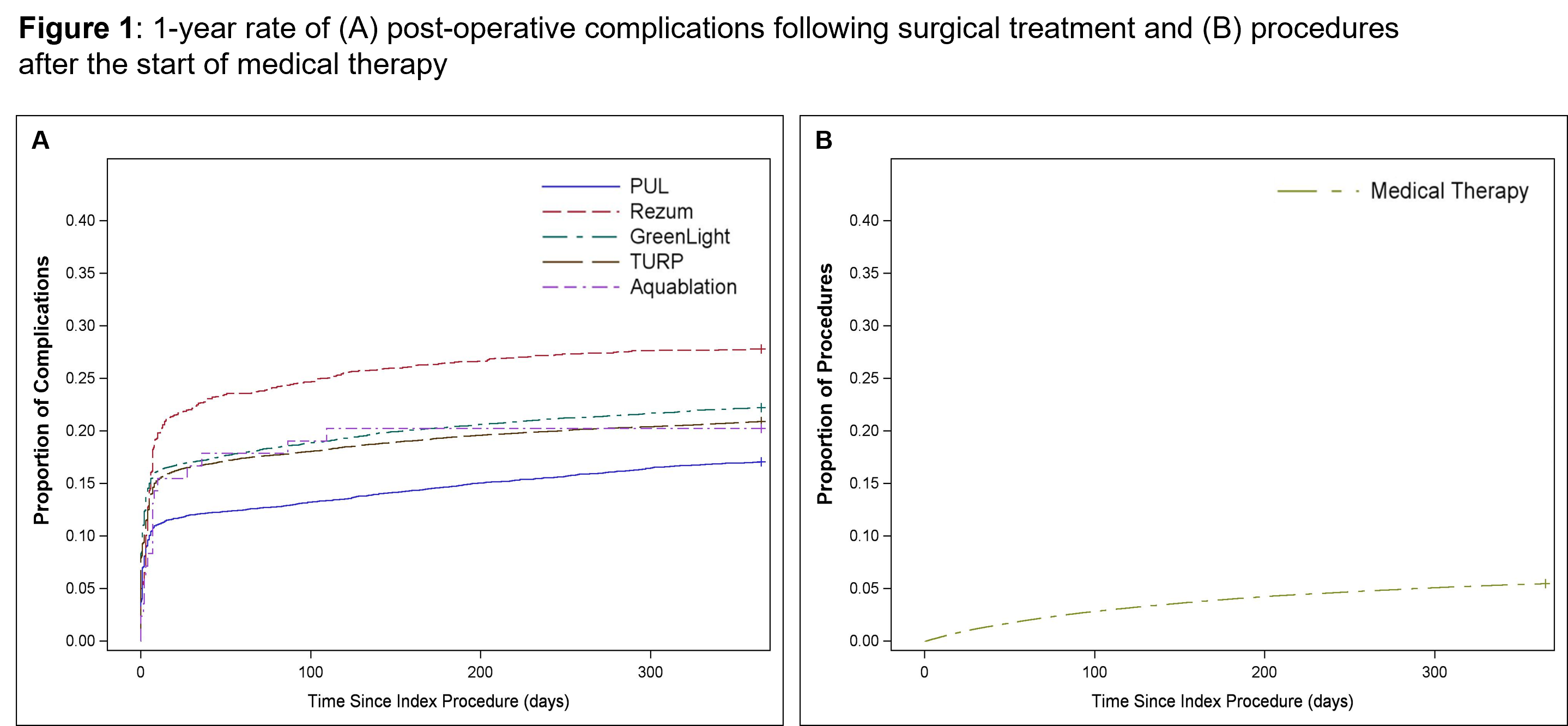Back
Introduction: To quantify the impact of BPH treatments in the real world, this healthcare utilization analysis attempts to compare complications and procedures subsequent to a surgical intervention vs. daily medication.
Methods: Patient-level data on men with BPH who received medical therapy only, MIST or invasive surgery in an outpatient setting from 2015-2021 were analyzed in a representative sample of US Medicare and commercial claims (IBM Watson). Procedures (post-operative following surgery or occurring after initiation of medical therapy) were identified with CPT codes. Overall event rates through 12 months post-treatment were calculated via cumulative incidence curves.
Results: 203,504 medical therapy patients were analyzed with average treatment of 716 days [most common medications: tamsulosin (n=75,698), Tadalafil (n=55,129)]. 5.5% of medication patients underwent procedures within the first year of treatment, the most frequent being cystoscopy (n=9,920), catheterization (n=1,792), and bladder irrigation (n=975). Mean time to onset for any event was 121d. Top diagnoses that drove cystoscopies included LUTS symptoms and urinary retention. For the surgical cohort, 24,035 TURP, 11,911 PVP, 84 Aquablation, 8,649 PUL, and 1,944 Rezum comprised the population. Procedural complication rates continued to be lowest after PUL (17%) with mean onset of 55d, highest for Rezum (28%, mean onset 29d), and comparable among the invasive surgeries: 20%, 21%, 22% for Aquablation (mean onset 18d), TURP (mean onset 35d), and PVP (mean onset 38d), respectively. Top complications for MIST and traditional surgeries were cystoscopies, catheterizations, and bladder irrigations.
Conclusions: Surgical intervention delivers treatment in one setting while medical therapy is affected by lack of compliance and discontinuation. We recognize the difficulties in comparing just one aspect of treatment complications between two treatment paradigms. We reveal ~6% of medical therapy patients undergo procedures through 1 year as disease progresses. Procedure complication rates were similar between TURP and PVP yet lowest for PUL. Although the Aquablation data are relatively immature due to the newness of the technology, the 20% rate reflects a safety profile similar to TURP and higher than PUL. SOURCE OF
Funding: Teleflex

Moderated Poster Session
Session: MP76: Benign Prostatic Hyperplasia: Surgical Therapy & New Technology IV
MP76-03: Procedural Complications Associated with MIST and Invasive Surgery Compared to Disease Progression with Medical Therapy
Monday, May 1, 2023
9:30 AM – 11:30 AM CST
Location: S405
- SK
Steven Abraham Kaplan, MD
Icahn School of Medicine at Mount Sinai
Poster Presenter(s)
Introduction: To quantify the impact of BPH treatments in the real world, this healthcare utilization analysis attempts to compare complications and procedures subsequent to a surgical intervention vs. daily medication.
Methods: Patient-level data on men with BPH who received medical therapy only, MIST or invasive surgery in an outpatient setting from 2015-2021 were analyzed in a representative sample of US Medicare and commercial claims (IBM Watson). Procedures (post-operative following surgery or occurring after initiation of medical therapy) were identified with CPT codes. Overall event rates through 12 months post-treatment were calculated via cumulative incidence curves.
Results: 203,504 medical therapy patients were analyzed with average treatment of 716 days [most common medications: tamsulosin (n=75,698), Tadalafil (n=55,129)]. 5.5% of medication patients underwent procedures within the first year of treatment, the most frequent being cystoscopy (n=9,920), catheterization (n=1,792), and bladder irrigation (n=975). Mean time to onset for any event was 121d. Top diagnoses that drove cystoscopies included LUTS symptoms and urinary retention. For the surgical cohort, 24,035 TURP, 11,911 PVP, 84 Aquablation, 8,649 PUL, and 1,944 Rezum comprised the population. Procedural complication rates continued to be lowest after PUL (17%) with mean onset of 55d, highest for Rezum (28%, mean onset 29d), and comparable among the invasive surgeries: 20%, 21%, 22% for Aquablation (mean onset 18d), TURP (mean onset 35d), and PVP (mean onset 38d), respectively. Top complications for MIST and traditional surgeries were cystoscopies, catheterizations, and bladder irrigations.
Conclusions: Surgical intervention delivers treatment in one setting while medical therapy is affected by lack of compliance and discontinuation. We recognize the difficulties in comparing just one aspect of treatment complications between two treatment paradigms. We reveal ~6% of medical therapy patients undergo procedures through 1 year as disease progresses. Procedure complication rates were similar between TURP and PVP yet lowest for PUL. Although the Aquablation data are relatively immature due to the newness of the technology, the 20% rate reflects a safety profile similar to TURP and higher than PUL. SOURCE OF
Funding: Teleflex

